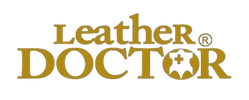Leather Repair Kit A7.r by Leather Doctor is a patching, filling, bonding, and smoothening repair system that supplements refinishing kits.
Leather Repair Kit A7.r comprises:
1oz - Leather Abrasion Repairer R4 by Leather Doctor is a water-based compact resin to smooth dog and cat scratches, and abraded edges of soft skin leathers.
Hydrating (Hydrator 3.3) and fatliquoring (Fatliquor 5.0) aged and dry rotting leather before repairs are highly recommended.
Instruction:
- Test for darkening effect for satisfaction,
- Apply using appropriate tools accordingly.
- Smooth with a spoon in one direction to build skin.
- The repair is ready for further color or top coating.
1oz - Leather Stucco 9S by Leather Doctor is a concentrated, compact resin blend for filling repairs or custom blending with Glue 3D, Pigment 54, or Aniline 76.
Tips:
- Relax with Hydrator 3.3 and soften with Fatliquor 5.0 of dried stiff leather before repair.
- Use Repairer R4 to smooth abrasion.
- Blend with Glue 3D for added strength and flexibility in high-stress areas.
Instruction:
- Apply to a cleaned surface for better anchorage and adhesion.
- Clean up surrounding areas immediately with a damp towel and let dry.
- Refill as necessary and leave 4 to 8 hours of curing time.
- Sand the repair surface seamlessly with fine sandpaper.
- The repair is ready for refinishing.
1oz - Leather Glue 3D by Leather Doctor is a water-based, medium-soft leather adhesive for tears, rips, cat scratches, and bonding repairs.
- Unlike other dry solvent-based glue, Glue 3D does not lift leather finishes.
- Glue 3D works with Leather Patch 4S as a sub-patch or suede fibers as fillers.
1. Instruction - How to Repair a Cut-Through Leather with Glue 3D?
- Cut-through repairs utilize Patch 4S as a leather sub-patch, and this is bonded suede side to suede side.
- Where tension causes the leather to open, it is stretched to an overlapping position with some pulling help.
- Preferably, the Patch 4S is glued to one side before gluing the other.
- A blower helps to speed up the drying process.
- Holding the rip in position until fully cured is recommended.
- Filling gaps may be done with added matching coloring for aesthetics.
2. Instruction - How to Repair a Fresh and Clean Accident Leather Abrasion with Glue 3D?
- Abrasion, in most cases, will roughen up the leather structure with missing finishes.
- Any soiling is removed by brushing before applying Glue 3D to smooth the damage.
- A repeat application is necessary to build smooth skin back.
- Color matching is done according to the finish types.
3. Instruction - How to Repair a Prolonged Contaminated Leather Abrasion & Holes with Glue 3D?
- Constant abrasion with repeated compression may loosen and weaken the leather structure, compounded with a loss of fibers or missing parts. Repairs are done as follows:
- Degreaser 2.2 is recommended to remove surface and penetrated oil and grease soiling in conjunction with Acidifier 2.0 to remove foreign contamination.
- Hydrator 3.3 followed by Fatliquor 5.0 is recommended to rejuvenate the leather with softness and strength.
- Repairer R4 is recommended for shallow abrasions.
- Glue 3D commences with smoothening and filling with donor suede fiber.
4. Instruction - How to Repair Hair-on-Hide Rug Rip or Tear Repair with Glue 3D?
- Rip or tear from aging or alkaline overexposure results from diminished fatliquor (ionic charged fat and oil).
- The hide needs to be cleaned (pH 1.5), rinsed (Acidifier 2.0), hydrated (Hydrator 3.3) and fatliquored (Fatliquor 5.0) before repairing, otherwise, the stiff hide may tend to tear again when flexed.
- The repair may be performed with Patch 4S, stitching, or suede fibers.
5. Instruction - How to Repair Hair-on-Hide Rug with Glue 3D and Patch 4S?
- A 1” Patch 4S strip sufficiently bonds a rip with approximately 1/2” on both sides.
- Glue 3D is applied to half an inch along the rip to penetrate, and the 1” Patch 4S is applied half sufficiently.
- The Patch 4S is placed and pressed accordingly.
- Let naturally dry with the hair drying option before repeating the other half and aligning accordingly.
- Let it overnight cure, and the hide is ready to flip over to the hair side.
6. Instruction - How to Repair Hair-on-Hide Rug with Glue 3D by Stitching and Donor Fiber?
- The hide is cross-stitched with a curved needle to hold the rip together.
- Glue 3D is applied about ½” on both sides of the rip.
- Donor fiber is scraped with Razor 60 from the thicker head and shoulder areas and applied over the stitching, camouflaging it.
- The repair is naturally dry or may be dried with a hair dryer.
4x6 inch - Leather Patch 4S by Leather Doctor is a smooth full-grain lambskin with suede on the other side for rip or tear repairs with a thickness of only 0.4mm, which becomes less noticeable at the edges.
Instruction:
- Grain-to-suede bonding is recommended for open surface grain repairs.
- Suede-to-suede bonding is recommended for closed grain repairs.
- Always use it in conjunction with Glue 3D.
Your opinions and insights are precious and will help us to improve our writing and communication to solve your leather problem more efficiently.
Edited: October 23, 2024 | April 14, 2025 by Roger Koh







